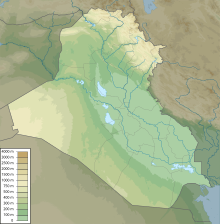| Al-Karmah offensive | |||||||
|---|---|---|---|---|---|---|---|
| Part of the War in Iraq | |||||||
 Location of the Al Anbar Governorate in Iraq | |||||||
| |||||||
| Belligerents | |||||||
|
Air support: |
| ||||||
| Commanders and leaders | |||||||
|
|
(ISIL Commander in Anbar) | ||||||
| Units involved | |||||||
| |||||||
| Strength | |||||||
|
| Several thousand | ||||||
| Casualties and losses | |||||||
| Unknown | 676+ killed (government claim)[8] | ||||||
Location within Iraq | |||||||
The Al-Karmah offensive, codenamed Fajr al-Karma,[9] was an offensive launched by the Iraqi Army and anti-ISIL Sunni tribal fighters to recapture the Al-Karmah district taken by the Islamic State of Iraq and the Levant in Iraq. The offensive began on 14 April 2015. During the offensive the anti-ISIL forces captured part of the city of Al-Karmah,[3] and the old road of Al-Karmah.[10]
In response to the Iraqi state offensive, ISIL launched a counterattack in the region, attacking Ramadi, capturing three nearby villages on 15 April,[11] and taking control of the Tharthar Dam on 24 April.[12] By 15 May ISIS had taken control over the Iraqi government headquarters in Ramadi.[13]
The ISIL attack on Ramadi prompted 114,000 people to flee the region, according to UN officials, increasing the total number of refugees from Anbar since 2014 to over 400,000 people.[14]
- ^ "RAF air strikes in Iraq: December 2014". 22 January 2015.
- ^ Pugliese, David (13 January 2015). "Update on RCAF bombing raids against targets in Iraq". Defence Watch. Ottawa Citizen. Retrieved 14 January 2015.
- ^ a b "Iraqi forces advance against Daesh stronghold in west Anbar province". Albawaba. Retrieved 27 April 2015.
- ^ Masi, Alessandria (11 November 2014). "If ISIS Leader Abu Bakr al-Baghdadi Is Killed, Who Is Caliph Of The Islamic State Group?". International Business Times. Retrieved 9 May 2015.
- ^ a b Sarhan, Amre (15 April 2015). "Iraqi warplanes kill, wound 62 ISIS elements in western Anbar". Iraq News. Retrieved 9 May 2015.
- ^ Sarhan, Amre (19 April 2015). "ISIS leader Abu Qatada and 55 terrorists killed by Iraqi and coalition air strikes in Anbar". Iraq News. Retrieved 9 May 2015.
- ^ Cite error: The named reference
ISIL executes 300was invoked but never defined (see the help page). - ^ 137+ killed on 14 April,[1][2] 43+ killed on 15 April,[3] 11+ killed on 17 April,[4] 77+ killed on 18 April,[5] 109+ killed on 19 April,[6][7] 35+ killed on 20 April,[8] 58+ killed on 21 April,[9] 21+ killed on 22 April,[10] 65+ killed on 27 April,[11] 14+ killed on 29 April,[12] 59+ killed on 2 May,[13] 47+ killed on 3 May,[14] a total of 676+ reported killed
- ^ "MoD: Iraqi army kills 14 terrorists, dismantles 95 IEDs in al-Karma District". Iraqi News. April 29, 2015.
- ^ "Iraqi army recaptures some areas from Daesh in Anbar province". Albawaba. Retrieved 27 April 2015.
- ^ "Islamic State opens major offensive in Iraq's Anbar province". SF Gate. 15 April 2015. Retrieved 16 April 2015.
- ^ "Islamic State takes military barracks, dam in Iraq's Anbar: sources". Reuters. 25 April 2015. Retrieved 26 April 2015.
- ^ Arango, Tim (15 May 2015). "ISIS Fighters Seize Government Headquarters in Ramadi, Iraq". The New York Times. Retrieved 15 May 2015.
- ^ "Over 114,000 flee fighting in Iraq's Ramadi area: UN". Your Middle East. 21 April 2015. Archived from the original on 1 November 2022. Retrieved 27 April 2015.
